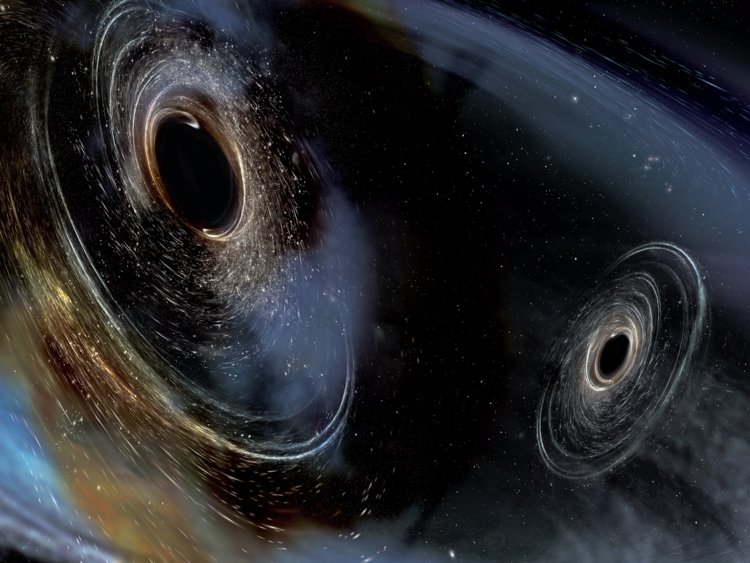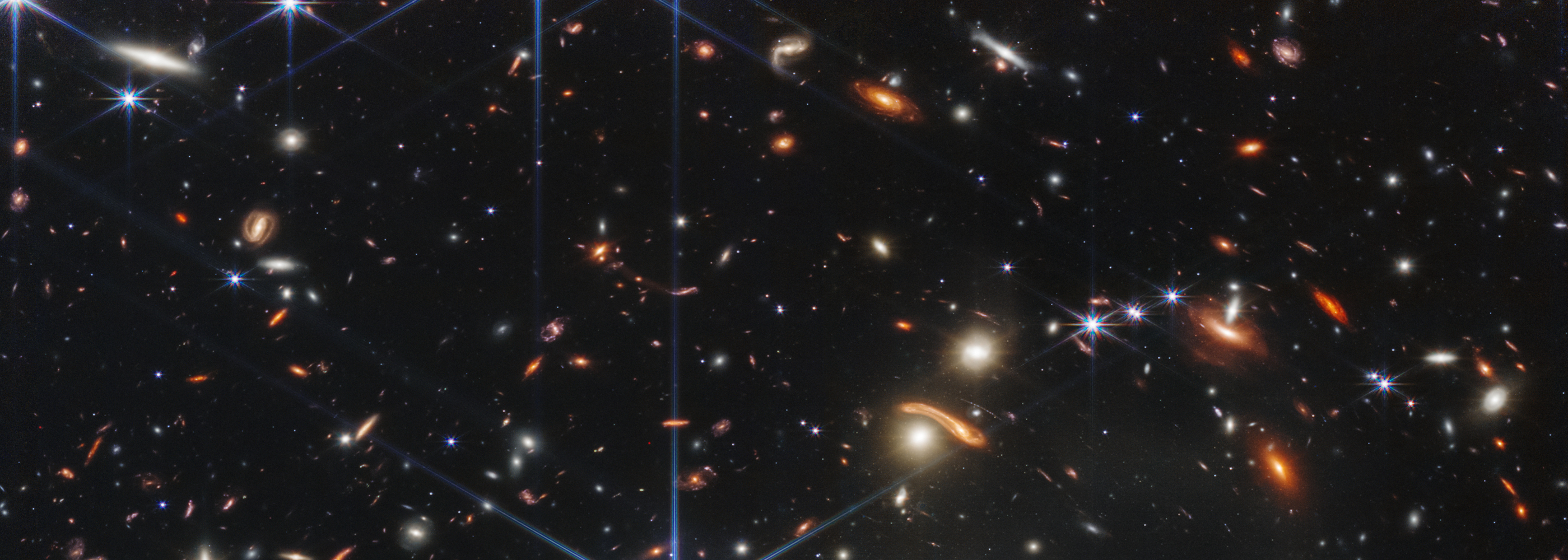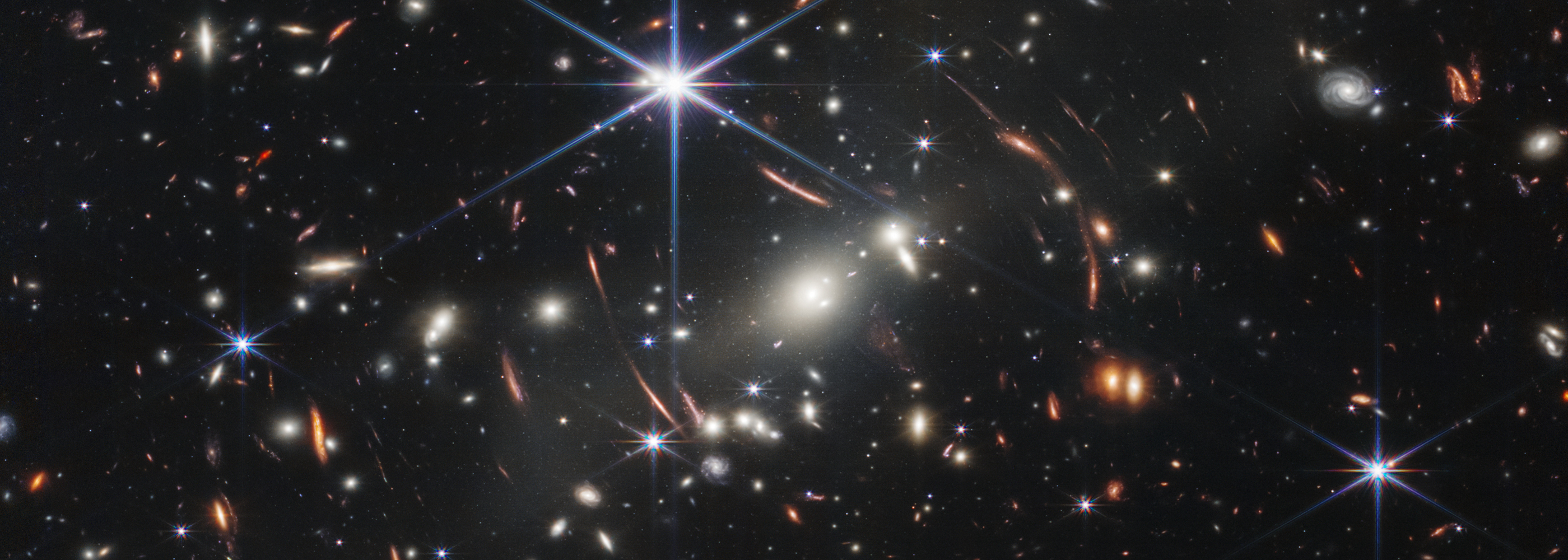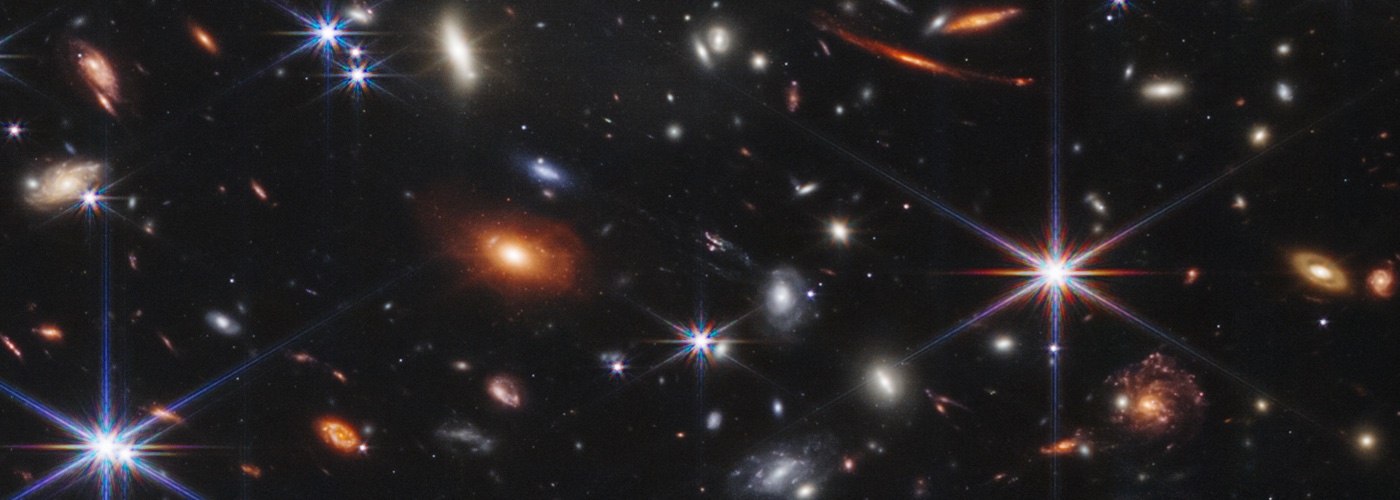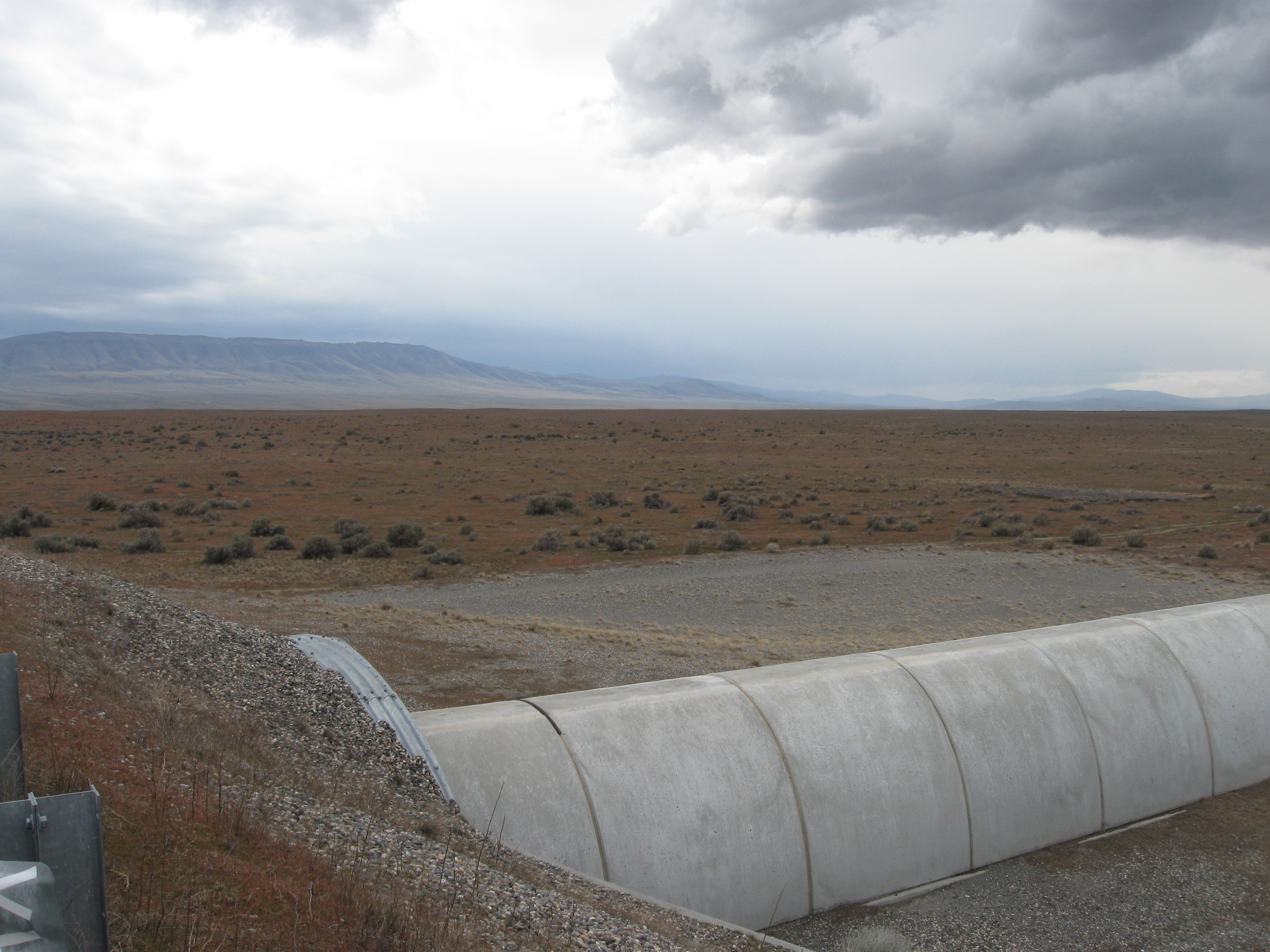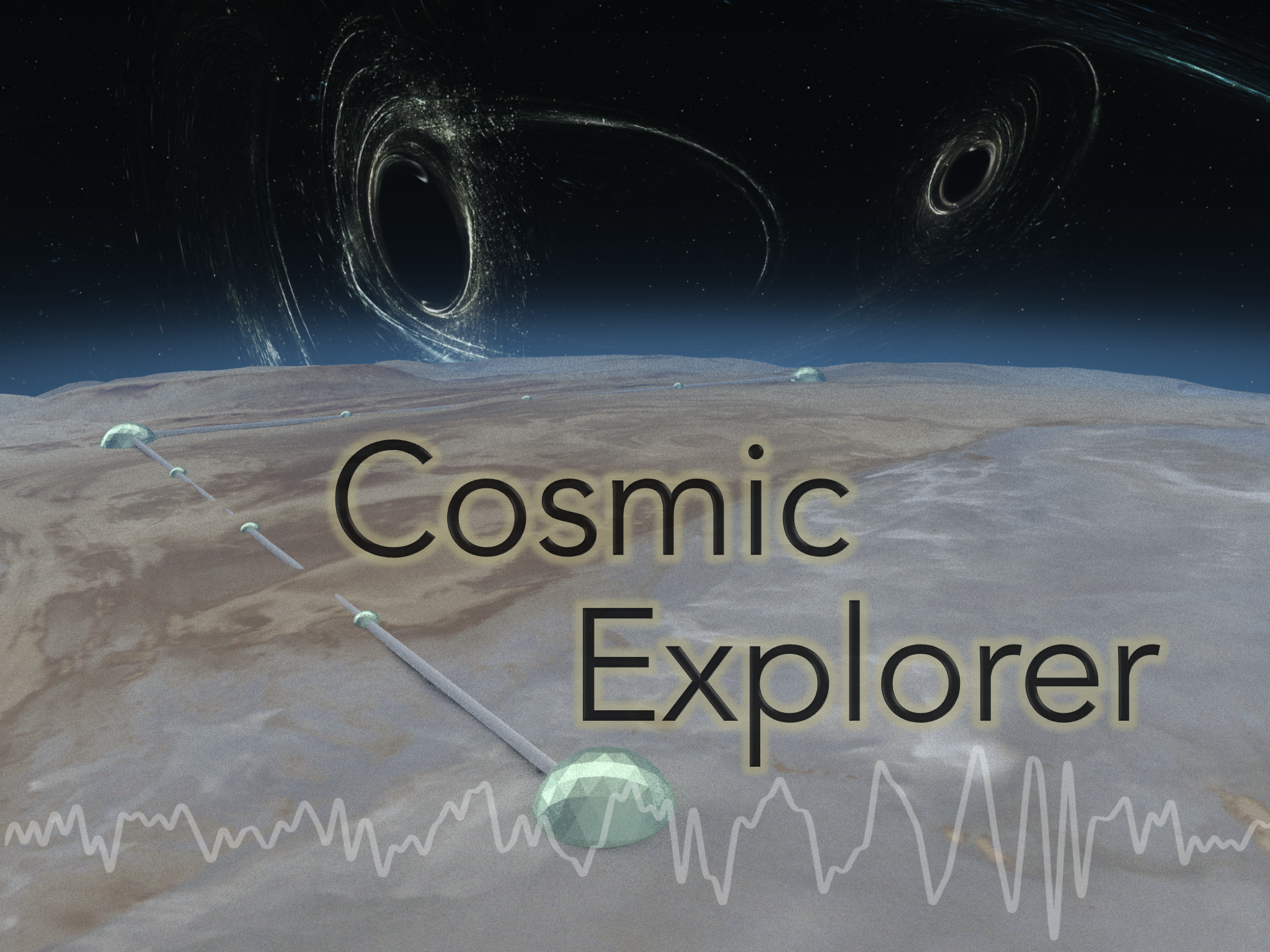Overview
Cosmic Explorer is a next-generation observatory concept that will greatly deepen and clarify humanity’s gravitational-wave view of the cosmos. It is the planned U.S. contribution to the global next-generation ground-based gravitational-wave observatory network. The design concept for Cosmic Explorer features two facilities, one 40 km on a side and one 20 km on a side, each housing a single L-shaped detector.
Cosmic Explorer together with other future detectors, including LISA and the Einstein Telescope, will be able to determine the nature of the densest matter in the universe; reveal the universe’s binary black hole and neutron star populations throughout cosmic time; provide an independent probe of the history of the expanding universe; explore warped spacetime with unprecedented fidelity; and expand our knowledge of how massive stars live, die, and create the matter we see today.
With its spectacular sensitivity, Cosmic Explorer will see gravitational-wave sources across the universe. Sources that are barely detectable by Advanced LIGO, Advanced Virgo, and Kagra will be resolved with incredible precision. The resulting explosion in the number of detected sources — up to millions per year — and the fidelity of observations will have wide-ranging impacts in physics and astronomy. By peering deep into the gravitational-wave sky, Cosmic Explorer will present a unique opportunity for new and unexpected discoveries.
See the Horizon Study for more information on Cosmic Explorer science, design and technology.
Layout
Like the current generation of observatories, Cosmic Explorer features an L-shaped geometry and houses a single interferometer. Each Cosmic Explorer facility will have two 40 km (20 km for the second site) ultrahigh-vacuum beam tubes, roughly 1 m in diameter, built in an L-shape on the surface of flat and seismically quiet land in the United States. This conventional design leverages decades of experience with current gravitational-wave detectors to ensure project success.
Scale
Cosmic Explorer’s 40 km arms (20 km for the second site), 10 (5) times longer than Advanced LIGO’s, will increase the amplitude of the observed signals with effectively no increase in the noise. Although there are areas of detector technology where improvements will lead to increases in the sensitivity and bandwidth of the instruments, the dominant improvement will come from significantly increasing the arm length.
Technology
Cosmic Explorer will be built with the technology developed for the A+ upgrade to Advanced LIGO, scaled up to a 40 km and 20km observatories with correspondingly better sensitivity. Planned upgrades to Cosmic Explorer will allow it to realize a full order of magnitude sensitivity improvement beyond Advanced LIGO.
Science
Seeing Black Holes Merge Throughout Cosmic Time
Advanced LIGO's observations of black holes merging in 2015, GW150914, gave humanity a glimpse of a previously unknown side of the Universe. Cosmic Explorer can detect merging stellar-mass black holes at redshifts of up to z ∼ 20. This immense reach will reveal for the first time the complete population of stellar-mass black holes, starting from an epoch when the universe was still assembling its first stars. Cosmic Explorer will detect hundreds of thousands of black-hole mergers each year, measuring their masses and spins. These observations will reveal the black-hole merger rate, the underlying star formation rate, how both have changed throughout cosmic time, and how both are correlated with galaxy evolution.
Investigating the Densest Matter in the Universe
Neutron stars are made of the densest stable matter in the universe. Six decades after their discovery, we still do not understand how matter behaves at the pressures and densities found in neutron-star interiors. The first neutron star merger, GW170817, was found in gravitational waves and observed across the electromagnetic spectrum. Observations of the mergers and remnants of neutron stars with gravitational waves and light illuminate unknown physics in the state of matter at ultra-high densities. Cosmic Explorer will capture these mergers with the precision needed to understand dense neutron-rich matter.
Exploring the Gravitational Wave Frontier
Cosmic Explorer might see other spectacular sources, the detection of any one of which would be revolutionary. Examples include the core collapse of a massive star in the Milky Way or Magellanic Clouds, emissions from mountains or quakes in pulsars, and glitches in magnetars in our galaxy. Cosmic Explorer might also see gravitational waves from forms of dark and exotic matter around black holes or in the cores of neutron stars, the mergers of primordial black holes formed in the early universe, or gravitational-wave emission from cosmic (super)strings.
Impact
Broader Context
Cosmic Explorer is a visionary project, not just for the advances in gravitational-wave science, but also as a model for how science can be more impactful when it is done in interdisciplinary, socially connected ways. The CE observatories will reshape the field of gravitational-wave astrophysics and impact the future of current early career researchers. The Decadal Survey on Astronomy and Astrophysics 2020 (Astro2020) Panel on the State of the Profession and Societal Impacts identified seven essential goals for the State of the Profession in the next decade. The large physical scale of the CE observatories, and the potential social, cultural, and economic impacts of their construction and presence, means that the success of Cosmic Explorer will depend on developing ongoing, positive partnerships with local and Indigenous communities.
Indigenous Partnerships
The work of the Indigenous Partnership Program will be to respectfully collaborate with Indigenous communities to develop mutually beneficial relationships and resources; appropriately integrate Indigenous science; demonstrate how scientific facilities can foster positive interactions with Indigenous communities; and, create frameworks for facilities construction that integrate the interests, priorities, and goals of Indigenous communities from initial conception through decommissioning. This work will set a precedent for protocol around facilities construction and the scientific approach that places community interests and culture at the center of process from conception; promoting transparent, trustworthy, and engaged science; and, building capacity within Indigenous and local communities to engage with the scientific community in ways that are respectful of culture and traditional knowledge and uphold community rights, interests, values, and consent.
Community
A strength of the Cosmic Explorer community is the involvement of university faculty, staff, and students. Central coordination of community efforts and analysis of qualitative data by the CE leadership provides structure and resources to the CE community to facilitate and assess activities, and to identify effective practices. The University of Washington Center for Evaluation and Research for STEM Equity (CERSE) uses qualitative data to advise on strategic planning and organizational development to improve communication and enhance participation. CE is connected to the scientific community through the Gravitational Wave Early Career Scientists (GWECS), Multimessenger Diversity Network (MDN), the International Gravity Outreach Group (IGrav), and the GW Allies to facilitate the sharing of resources and best practices.
News
US 3G
Economic and Qualitative Impacts Study of Einstein Telescope Carried out By Economic and Planning Services, Inc
On November 21, 2025, the land economics consulting firm Economic and Planning Services Inc.. completed a report highlighting Cosmic Explorer’s projected local economic impacts, from both one-time construction and annual ongoing operations, and broader qualitative benefits ranging from community impacts to advances in scientific research and technological innovations.
Read the full report here.And highlights for the 40km observatory here.
by Joshua Smith on December 2, 2025
NSF’s MPS Advisory Subcommittee recommends Cosmic Explorer be selected as the Next-Generation US-based Gravitational Wave Observatory
National Science Foundation’s Mathematical and Physical Sciences Next-Generation Gravitational Wave Observatory Subcommittee’s report recommends that the Cosmic Explorer Observatory concept will be adopted by the NSF.[1]
Vicky Kalogera, Daniel I. Linzer Distinguished University Professor at Northwestern University and chair of the subcommittee, presented the findings at a March 26 meeting of the National Science Foundation’s MPS Advisory Committee. She highlighted the broad scientific discovery potential for next-generation gravitational-wave facilities and emphasized that the Cosmic Explorer 40km detector design has extraordinary potential for new discoveries while at the same time carrying the lowest technical risk. A variety of networks were recommended which include the operation of two Cosmic Explorer observatories in the US, LIGO India, and Europe’s Einstein Telescope. She emphasized the importance of Cosmic Explorer as a long-term investment in US science infrastructure. [1] The subcommittee’s report can be found here.by Stefan Ballmer on April 2, 2024
Read moreNational Science Foundation Awards Significant Funding to the Members of the Cosmic Explorer Project
The National Science Foundation awarded funding to a set of coordinated proposals submitted by members of the Cosmic Explorer Project — a significant level of support totaling approximately $9M USD over the coming three years. The twelve institutions that will be supported by these awards have a diverse and geographically broad span; they are Bard College, California State University Fullerton, California Institute of Technology, Massachusetts Institute of Technology, Penn State University, University of California Riverside, Syracuse University, the University of Arizona, the University of Florida, the University of Minnesota, the University of Oregon, and the University of Washington Bothell.
by Stefan Ballmer on August 23, 2023
Read moreCosmic Explorer Project Submits a White Paper in Response to NSF’s Next Generation Gravitational-Wave Committee’s Call
The National Science Foundation (NSF) appointed a sub-committee next-generation Gravitational Wave committee (ngGW) of the Mathematical and Physical Sciences Advisory Committee (MPSAC) to assess and recommend configurations for a U.S. GW detection network that can operate at a sensitivity approximately an order of magnitude greater than that of LIGO A+ by the middle of the next decade. The CE project conducted a trade study to assess the relative performances of plausible detector networks operating in the 2030s and summarized the findings in the White Paper submitted in response to that call.
by B.S. Sathyaprakash on August 4, 2023
Read moreDawn VI Meeting on Next Generation Observatories Endorses Cosmic Explorer, December, 2021
The Dawn VI Meeting on Next Generation Observatories brought together over 200 physicists and astronomers in October 2021 to discuss the next-generation ground-based gravitational-wave detectors. The report from this meeting, published in December 2021, has endorsed Cosmic Explorer stating:
"There was a consensus that Cosmic Explorer is a concept that can deliver the promised science. A strong endorsement of Cosmic Explorer, as described in the CE Horizon Study, is a primary outcome of DAWN VI."
To endorse the DAWN VI report, or for any questions, send email to David Shoemaker.
by Duncan Brown on December 24, 2021
Astro2020 Decadal Survey: A Resounding Endorsement for Cosmic Explorer, November, 2021
The National Academies' 2020 Decadal Survey on Astronomy and Astrophysics resoundingly endorsed Cosmic Explorer, stating that a next-generation gravitational-wave observatory in the United States is "central to achieving the science vision laid out in the survey’s roadmap." The Cosmic Explorer Consortium appreciates the support we have received from the Astro 2020 survey, which states that:
"Gravitational wave astrophysics is one of the most exciting frontiers in science. One of the survey’s key priorities is the opening of new windows on the dynamic universe, with gravitational wave detection at the forefront. The continued growth in sensitivity of current-generation facilities, such as LIGO, through phased upgrades and planning the next-generation observatory, such as Cosmic Explorer, is essential. This will require investment in technology development now. The survey committee strongly endorses gravitational wave observations as central to many crucial science objectives."
by Matthew Evans on November 5, 2021
Cosmic Explorer Horizon Study, July, 2021
The Cosmic Explorer Horizon Study is now public! This is a near-final draft of the report, with work on-going to incorporte community input.
by Matthew Evans on July 21, 2021
Cosmic Explorer meeting, October 26–30, 2020
The first Cosmic Explorer meeting will be held online, October 26–30, to discuss the science case and technical design for next-generation, ground-based gravitational-wave detectors. Learn more at the conference webpage. The deadline to register is October 20.
by Evan Hall on October 1, 2020
Study Detectability of Supernovae by Cosmic Explorer published by Physical Review
Syracuse University graduate student Varun Srivastava's study on the detectability of supernovae with Cosmic Explorer has been published in Physical Review D and is available at https://journals.aps.org/prd/abstract/10.1103/PhysRevD.100.043026.
by Duncan Brown on September 16, 2019
Read moreCosmic Explorer White Paper for Astro2020 Decadal Survey Submitted
Together with members of the LIGO lab, the Cosmic Explorer team wrote and submitted “Cosmic Explorer: The U.S. Contribution to Gravitational-Wave Astronomy beyond LIGO,” an Astro2020 Decadal Survey APC ground-based technology development white paper. The white paper is available online at https://arxiv.org/abs/1907.04833.
by Geoffrey Lovelace on August 5, 2019
Read moreUS 3G Effort Funded by NSF
The National Science Foundation has awarded a collaborative grant to 5 US institutions to study the science case for an international network of next-generation gravitational-wave detectors, and the potential avenues for construction of a 3G detector in the United States [award 1836814].
The grant started in August, 2018, and the collaboration is working with the GWIC 3G effort to develop a comprehensive vision of 3G science. Development of a cost model for Cosmic Explorer is also an integral part of the work, which is currently incorporating the results of the NSF Workshop on Large Ultrahigh Vacuum Systems for Frontier Scientific Research Instrumentation [award 1846124, final report].
by Matthew Evans on March 13, 2019
Read more